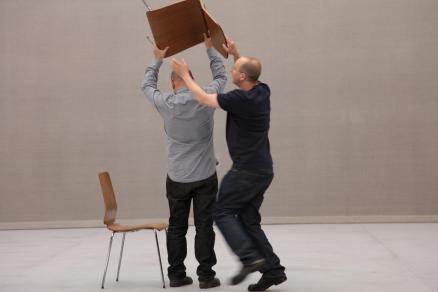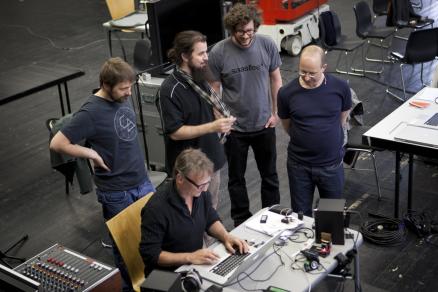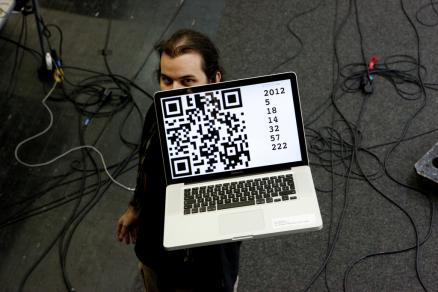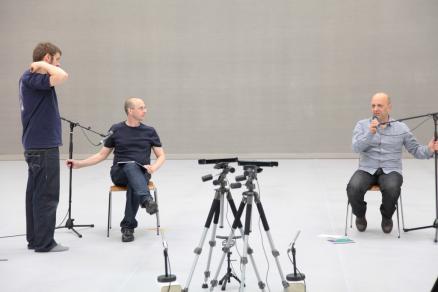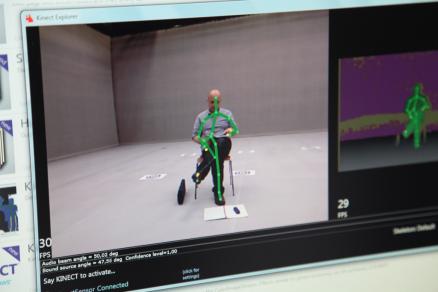Jonathan Burrows & Matteo Fargion Test Filming
Jonathan Burrows & Matteo FargionTest Filming May 2012In preparation for the three filming days (16, 17 and 18 May 2012) Nik Haffner had distributed notes following the April 2012 research meeting. Day one was scheduled to film fragments of Both Sitting Duet & Speaking Dance. Day Two for The Quiet Dance & Counting to One Hundred. Day Three for Cow Piece, Cheap Lecture and the new work One Flute Note. |
|
|
The aim was to film in a similar “lab atmosphere” used to shoot the material of Deborah Hay. This meant filming for both computer vision and material that might later be published online. Jonathan and Matteo's material incorporates sound from multiple sources, clapping, vocal utterance, objects, musical instruments, pre-recorded, etc. so accurate audio recordings were critical. All recordings would need to be synchronised using both hand held clapper and a QR pattern shown to each camera. |
|
|
For an impression of the lab set up, see the short videos at the end of this report. Piecemaker (operated by Martin Streit) was used to record and make notes during the fragment recordings. And the scores Jonathan and Matteo use in performance were photographed and scanned (these are all available on their website Seven Duets). A list of all fragments recorded during the May test filming and notes for the final September filming can be downloaded here. |
|
|
Because Jonathan & Matteo perform much of their material in a relatively confined space (sitting or standing) their project made more sense for using Microsoft's Kinect system as compared to Deborah Hay's. Setting up and running the Kinect system was taken over by Svenja Kahn & Jens Keil from score partner Fraunhofer IGD. Through participation in Microsoft's Kinect for Windows Testing and Adoption Program (TAP), Svenja and Jens were able to use and give feedback on pre-public release software for the Kinect. |
|
|
The pre-release Microsoft Kinect software made it possible to record Kinect data first and then to estimate the human poses in a post-processing step -- something which was not possible with their public version at that time. Svenja Kahn's detailed report on the Kinect Setup and Recording for Jonathan & Matteo's test filming including information on Spatial Calibration and Camera Synchronisation as well as the feedback for Microsoft can be downloaded here. |
|
|
Video Impression: Test Filming Jonathan Burrows and Matteo Fargion |
|
|
Video Impression: Test Filming Jonathan Burrows and Matteo Fargion |
|
|
Video Impression: Test Filming Jonathan Burrows and Matteo Fargion |
|
Jonathan Burrows & Matteo Fargion Process Documentation Pages:
http://motionbank.org/en/content/jonathan-burrows-matteo-fargion
http://motionbank.org/en/event/jonathan-burrows-matteo-fargion-research-sessions
http://motionbank.org/en/event/jonathan-burrows-matteo-fargion-test-filming
http://motionbank.org/en/event/jonathan-burrows-matteo-fargion-guest-performances
http://motionbank.org/en/event/jonathan-burrows-matteo-fargion-final-filming
http://motionbank.org/en/event/jonathan-burrows-matteo-fargion-score-production-sessions
INFO
As a response to the COVID-19 / Corona situation we just opened our research system (including Piecemaker and MoSys) for dance education and practice.
This year Motion Bank celebrates it's 10 anniversary. As soon as it becomes possible to make final plans we will release information about these.
Please consider subscribing to our newsletter.

